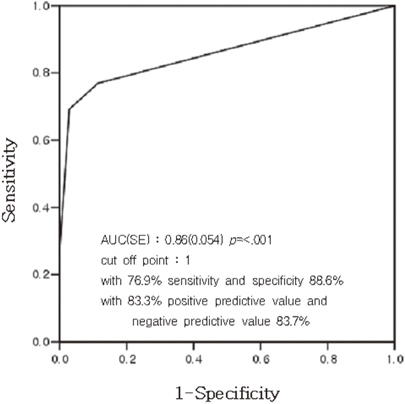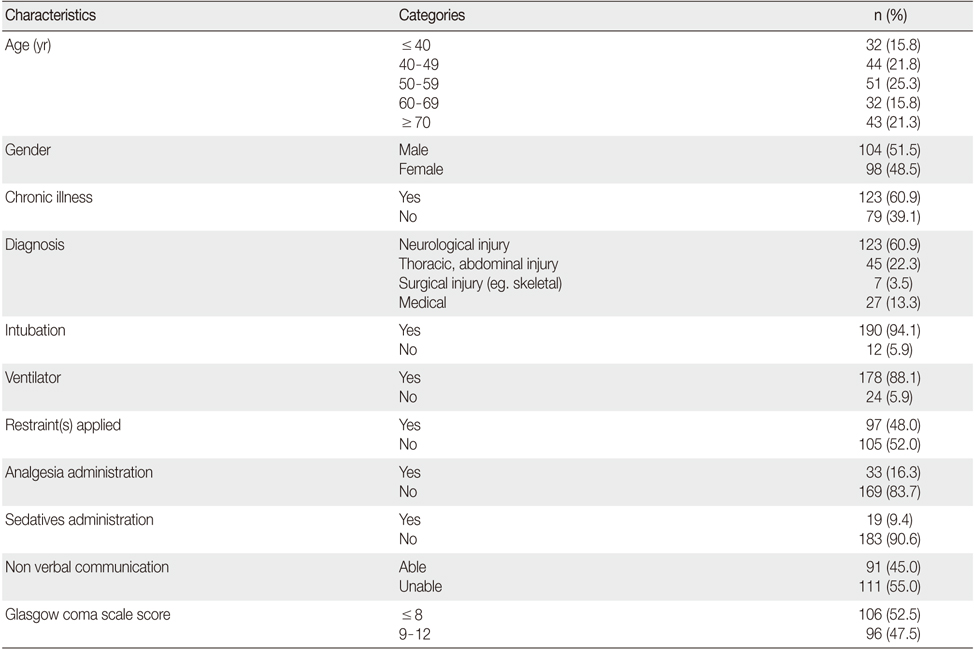Articles
- Page Path
- HOME > J Korean Acad Nurs > Volume 42(1); 2012 > Article
-
Original Article
- Validation of a Korean Translated Version of the Critical Care Pain Observation Tool (CPOT) for ICU Patients
- Eun-Mi Kwak, Heeyoung Oh
-
Journal of Korean Academy of Nursing 2012;42(1):76-84.
DOI: https://doi.org/10.4040/jkan.2012.42.1.76
Published online: February 29, 2012
1Nurse, Eulji University Hospital, Deajeon, Korea.
2Professor, College of Nursing, Eulji University, Deajeon, Korea.
- Address reprint requests to: Oh, Heeyoung. College of Nursing, Eulji University, 143-5 Yongdu-dong, Jung-gu, Daejeon 301-832, Korea. Tel: +82-42-259-1713, Fax: +82-42-259-1709, hoh123@eulji.ac.kr
• Received: April 13, 2011 • Accepted: February 5, 2012
© 2012 Korean Society of Nursing Science
- 1,095 Views
- 8 Download
- 16 Crossref
Abstract
-
Purpose
- The purpose of this methodological study was to examine the reliability and validity of a translated Korean version of the Critical Care Pain Observation Tool (CPOT) developed for assessment of pain in critically ill nonverbal patients.
-
Methods
- A cross-sectional study design was used. Data were collected from a convenience sample of 202 critically ill patients admitted to a university hospital. Upon establishment of content and translation equivalence between the English and Korean version of CPOT, psychometric properties were evaluated.
-
Results
- The interrater reliability was found to be acceptable with the weighted kappa coefficients of .81-.88. Significant high correlations between the CPOT and the Checklist of Nonverbal Pain Indicators were found indicating good concurrent validity (r=.72-.83, p<.001). Data showed the area under the ROC curve of 0.86 with a cut-off point of 1, which resulted in 76.9% sensitivity and 88.6% specificity. The mean score of CPOT during suctioning was significantly different from that of before (t=-14.16, p<.001) or 20 minutes after suctioning (t=16.31, p<.001).
-
Conclusion
- Results of this study suggest that the CPOT can be used as a reliable and valid measure to assess pain in critically ill nonverbal patients.
- 1. Berne R.M., Levy M.N. Cardiovascular physiology. 1986;5th ed. St Louis, MO, CV Mosby Co.
- 2. Bieri D., Reeve R.A., Champion G.D., Addicoat L., Ziegler J.B. The faces pain scale for the self-assessment of the severity of pain experienced by children: Development, initial validation, and preliminary investigation for ratio scale properties. Pain. 1990;41:139–150. http://dx.doi.org/10.1016/0304-3959(90)90018-9.ArticlePubMed
- 3. Cade C. Clinical tools for the assessment of pain in sedated critically ill adults. Nursing in Critical Care. 2008;13:288–297.ArticlePubMed
- 4. Carrasco G. Instruments for monitoring intensive care unit sedation. Critical Care. 2000;4:217–225. http://dx.doi.org/10.1186/cc697.PubMedPMC
- 5. Chapman D.W., Carter J. Translation procedures for the cross cultural use of measurement instruments. Educational Evaluation and Policy Analysis. 1979;1(3):71–76. http://dx.doi.org/10.3102/01623737001003071.ArticlePDF
- 6. Feldt K.S. The checklist of nonverbal pain indicators. Pain Management Nursing. 2000;1(1):13–21. http://dx.doi.org/10.1053/jpmn.2000.5831.ArticlePubMed
- 7. Fraser G.L., Riker R.R. Monitoring sedation, agitation, analgesia, and delirium in critically ill adult patients. Critical Care Clinics. 2001;17:967–988. http://dx.doi.org/10.1016/S0749-0704(05)70189-5.ArticlePubMed
- 8. Gélinas C., Fillion L., Puntillo K.A., Viens C., Fortier M. Validation of the critical-care pain observation tool in adult patients. American Journal of Critical Care. 2006;15:420–427.ArticlePubMedPDF
- 9. Gélinas C., Fillion L., Puntillo K.A. Item selection and content validity of the critical-care pain observation tool for non-verbal adult. Journal of Advanced Nursing. 2009;65:203–216. http://dx.doi.org/10.1111/j.1365-2648.2008.04847.x.ArticlePubMed
- 10. Gélinas C., Harel F., Fillion L., Puntillo K.A., Johnston C. Sensitivity and specificity of the critical-care pain observation tool for the detection of pain in intubated adults after cardiac surgery. Journal of Pain and Symptom Management. 2009;37(1):58–67.ArticlePubMed
- 11. Gélinas C., Johnston C. Pain assessment in the critically ill ventilated adult: Validation of the critical-care pain observation tool and physiologic indicators. The Clinical Journal of Pain. 2007;23:497–505. http://dx.doi.org/10.1097/AJP.0b013e31806a23fb.ArticlePubMed
- 12. Greiner M., Pfeiffer D., Smith R.D. Principles and practical application of the receiver-operating characteristic analysis for diagnostic tests. Preventive Veterinary Medicine. 2000;45:23–41. http://dx.doi.org/10.1016/S0167-5877(00)00115-X.ArticlePubMed
- 13. Hamill-Ruth R.J., Marohn M.L. Evaluation of pain in the critically ill patient. Critical Care Clinics. 1999;15:35–54. http://dx.doi.org/10.1016/S0749-0704(05)70038-5.ArticlePubMed
- 14. Hwang Y.H., Choe M.A. Study on the changes in limb circumferences and muscle areas of critically ill patients using ventilators. Journal of Korean Academy of Nursing. 2008;38:874–880. http://dx.doi.org/10.4040/jkan.2008.38.6.874.ArticlePubMed
- 15. Kim Y.H., Koo M.J., Kim S.H., Kim Y.M., Lee N.Y., Chang K.O. The experiences of patients in intensive care units. Journal of Korean Academy of Nursing. 2007;37:924–931.PubMed
- 16. Li D., Puntillo K., Miaskowski C. A review of objective pain measures for use with critical care adult patients unable to self-report. The Journal of Pain. 2008;9(1):2–10. http://dx.doi.org/10.1016/j.jpain.2007.08.009.ArticlePubMed
- 17. Nunnally J.C., Bernstein I.H.. Psychometric theory. 1994;3rd ed. New York, NY, McGraw-Hill.
- 18. Nygaard H.A., Jarland M. The checklist of nonverbal pain indictors(CNPI): Testing of reliability and validity in Norwegian nursing homes. Age and Ageing. 2006;35(1):79–81. http://dx.doi.org/10.1093/ageing/afj008.PubMed
- 19. Odhner M., Wegman D., Freeland N., Steinmetz A., Ingersoll G. Assessing pain control in nonverval critically ill adults. Dimensions of Critical Care Nursing. 2003;22:260–267.ArticlePubMed
- 20. Payen J.F., Bru O., Bosson J.L., Lagrasta A., Novel E., Deschaux I, et al. Assessing pain in critically ill sedated patients by using a behavioral pain scale. Critical Care Medicine. 2001;29:2258–2263.ArticlePubMed
- 21. Payen J.F., Chanques G., Mantz J., Hercule C., Auriant I., Leguillou J.L, et al. Current practices in sedation and analgesia for mechanically ventilated critically ill patients: A prospective multicenter patient-based study. Anesthesiology. 2007;106:687–695. http://dx.doi.org/10.1097/01.anes.0000264747.09017.da.ArticlePubMedPDF
- 22. Puntillo K.A., Morris A.B., Thomson C.L., Stanik-Hutt J., White C.A., Wild L.R. Pain behaviors observed during six common procedure: Result from thunder project II. Critical Care Medicine. 2004;32:421–427. http://dx.doi.org/10.1097/01.CCM.0000108875.35298.D2.ArticlePubMed
- 23. Puntillo K.A., Stannard D., Miakowski C., Kehrle K., Gleeson S. Use of pain assessment and intervention notation(P.A.I.N) tool in critical care nursing practice: Nurses evaluation. Heart & Lung. 2002;31:303–314. http://dx.doi.org/10.1067/mhl.2002.125652.Article
- 24. Sessler C.N., Varney K. Patient-focused sedation and analgesia in the ICU. Chest. 2008;133:552–565. http://dx.doi.org/10.1378/chest.07-2026.ArticlePubMed
- 25. Shannon K., Bucknall T. Pain assessment in critical care: What have we learnt from research. Intensive and Critical Care Nursing. 2003;19:154–162.ArticlePubMed
- 26. Siffleet J., Young J., Nikoletti S., Shaw T. Patients' self-report of procedural pain in the intensive care unit. Journal of Clinical Nursing. 2007;16:2142–2148. http://dx.doi.org/10.1111/j.1365-2702.2006.01840.x.ArticlePubMed
- 27. Stanik-Hutt J.A., Soeken K.L., Belcher A.E., Fontaine D.K., Gift A.G. Pain experience of traumatically injured patients in a critical care setting. American Journal of Critical Care. 2001;10:252–259.PubMed
- 28. Swets J.A. Measuring the accuracy of diagnostic systems. Science. 1988;240:1285–1293. http://dx.doi.org/10.1126/science.3287615.ArticlePubMed
- 29. Teasdale G., Jennett B. Assessment of coma and impaired consciousness. A practical scale. Lancet. 1974;2:81–84.PubMed
- 30. Wang H., Tsai Y. Nurse's knowledge and barriers regarding pain management in intensive care units. Journal of Clinical Nursing. 2010;19:3188–3196. http://dx.doi.org/10.1111/j.1365-2702.2010.03226.x.ArticlePubMed
REFERENCES
Figure & Data
REFERENCES
Citations
Citations to this article as recorded by 

- Validation of Nonverbal Pain Assessment Tools in Brain-Injured Patients
Ji-Young Lee, Sun-Kyung Hwang
Journal of Korean Critical Care Nursing.2025; 18(3): 64. CrossRef - Effect of an Intervention Using Voice Recording of a Family Member on Patients Undergoing Mechanical Ventilator Weaning Process
Ah Young Choi, Min Young Kim, Eun Kyeung Song
Journal of Korean Academy of Nursing.2024; 54(1): 32. CrossRef - Validation of the PAINAD-K Scale for Nonverbal Pain Assessment in the Post Anesthesia Care Unit
Hyemin Kang, Ju-Yeon Uhm
Journal of Korean Academy of Fundamentals of Nursing.2023; 30(1): 90. CrossRef - Pain assessment of the adult sedated and ventilated patients in the intensive care setting: A scoping review
Samira Hamadeh Kerbage, Loretta Garvey, Gavin W. Lambert, Georgina Willetts
International Journal of Nursing Studies.2021; 122: 104044. CrossRef - A Systematic Review on Pain Assessment Tools for Intensive Care Unit Patients
Eun-Jeong Kim, Jiwon Hong, Jiyeon Kang, Na geong Kim, NaRi Kim, Su-Youn Maeng, Hye-Ryeon Park, Min Kyung Ban, Gun Young Yang, Kyung Suk Lee, Eun Hye Jang
Journal of Korean Critical Care Nursing.2020; 13(1): 44. CrossRef - Translation into Spanish and Cultural Adaptation of the Critical-Care Pain Observation Tool
Carmen Mabel Arroyo-Novoa, Milagros I. Figueroa-Ramos, Kathleen A. Puntillo, Céline Gélinas
American Journal of Critical Care.2020; 29(3): 226. CrossRef - The Diagnostic Accuracy of Critical Care Pain Observation Tool (CPOT) in ICU Patients: A Systematic Review and Meta-Analysis
Yue Zhai, Shining Cai, Yuxia Zhang
Journal of Pain and Symptom Management.2020; 60(4): 847. CrossRef - Validation of the Dutch version of the critical‐care pain observation tool
Willemke Stilma, Saskia Rijkenberg, Hilde M Feijen, Jolanda M Maaskant, Henrik Endeman
Nursing in Critical Care.2019; 24(3): 132. CrossRef - The German version of the Critical-Care Pain Observation Tool for critically ill adults
I. Kiesewetter, U. Bartels, A. Bauer, G. Schneider, S. Pilge
Der Anaesthesist.2019; 68(12): 836. CrossRef - A Psychometric Analysis Update of Behavioral Pain Assessment Tools for Noncommunicative, Critically Ill Adults
Céline Gélinas, Aaron M. Joffe, Paul M. Szumita, Jean-Francois Payen, Mélanie Bérubé, Shiva Shahiri T., Madalina Boitor, Gerald Chanques, Kathleen A. Puntillo
AACN Advanced Critical Care.2019; 30(4): 365. CrossRef - Clinical Practice Guidelines for the Prevention and Management of Pain, Agitation/Sedation, Delirium, Immobility, and Sleep Disruption in Adult Patients in the ICU
John W. Devlin, Yoanna Skrobik, Céline Gélinas, Dale M. Needham, Arjen J. C. Slooter, Pratik P. Pandharipande, Paula L. Watson, Gerald L. Weinhouse, Mark E. Nunnally, Bram Rochwerg, Michele C. Balas, Mark van den Boogaard, Karen J. Bosma, Nathaniel E. Bru
Critical Care Medicine.2018; 46(9): e825. CrossRef - The Critical care Pain Observation Tool is reliable in non-agitated but not in agitated intubated patients
Hoda Chookalayia, Mehdi Heidarzadeh, Mohammad Hassanpour-Darghah, Masoomeh Aghamohammadi-Kalkhoran, Mansoreh Karimollahi
Intensive and Critical Care Nursing.2018; 44: 123. CrossRef - Processus d’implantation d’une échelle d’évaluation de la douleur pour les patients cérébrolésés : description d’un projet de changement de pratique clinique basé sur le Modèle Intégré de la Consultation
Véronique de Goumoëns, François Décaillet, Amélia Didier, Chantal Montreuil, Karin Diserens, Anne-Sylvie Ramelet
Recherche en soins infirmiers.2017; N° 128(1): 79. CrossRef - Validation of the Danish version of the Critical Care Pain Observation Tool
J. B. Frandsen, K. S. O'Reilly Poulsen, E. Laerkner, T. Stroem
Acta Anaesthesiologica Scandinavica.2016; 60(9): 1314. CrossRef - Comparison of Domestic and International Research (1992-2011): Intensive Care Nursing Studies
Eun Hee Choi, Eun Hee Jang, Ji Youn Choi, So Jung Lee, Hyo Kuyng Seo, Kyung Sook Park
Korean Journal of Adult Nursing.2015; 27(4): 384. CrossRef - The Effects of Music Intervention on Pain among Critically Ill Patients with Ventilatory Support
Mi Na Ahn, Hye Young Ahn
Journal of Korean Biological Nursing Science.2013; 15(4): 247. CrossRef
Validation of a Korean Translated Version of the Critical Care Pain Observation Tool (CPOT) for ICU Patients

Figure 1
ROC curve of CPOT at pre-exposure to suctioning in intensive care unit patients. (N=61)
Figure 1
Validation of a Korean Translated Version of the Critical Care Pain Observation Tool (CPOT) for ICU Patients
General and Health related Characteristics of Participants (N=202)
Interrater Reliability of Critical Care Pain Observation Tool (N=91)
Concurrent Validity of Critical Care Pain Observation Tool (N=202)
CPOT=Critical care pain observation tool; CNPI=Checklist of nonverbal pain indicators.
Discriminant Validity: Comparison of CPOT Scores Measured before, During, and after Suctioning (N=202)
Table 1
General and Health related Characteristics of Participants (N=202)
Table 2
Interrater Reliability of Critical Care Pain Observation Tool (N=91)
Table 3
Concurrent Validity of Critical Care Pain Observation Tool (N=202)
CPOT=Critical care pain observation tool; CNPI=Checklist of nonverbal pain indicators.
Table 4
Discriminant Validity: Comparison of CPOT Scores Measured before, During, and after Suctioning (N=202)
 KSNS
KSNS
 E-SUBMISSION
E-SUBMISSION





 Cite
Cite

